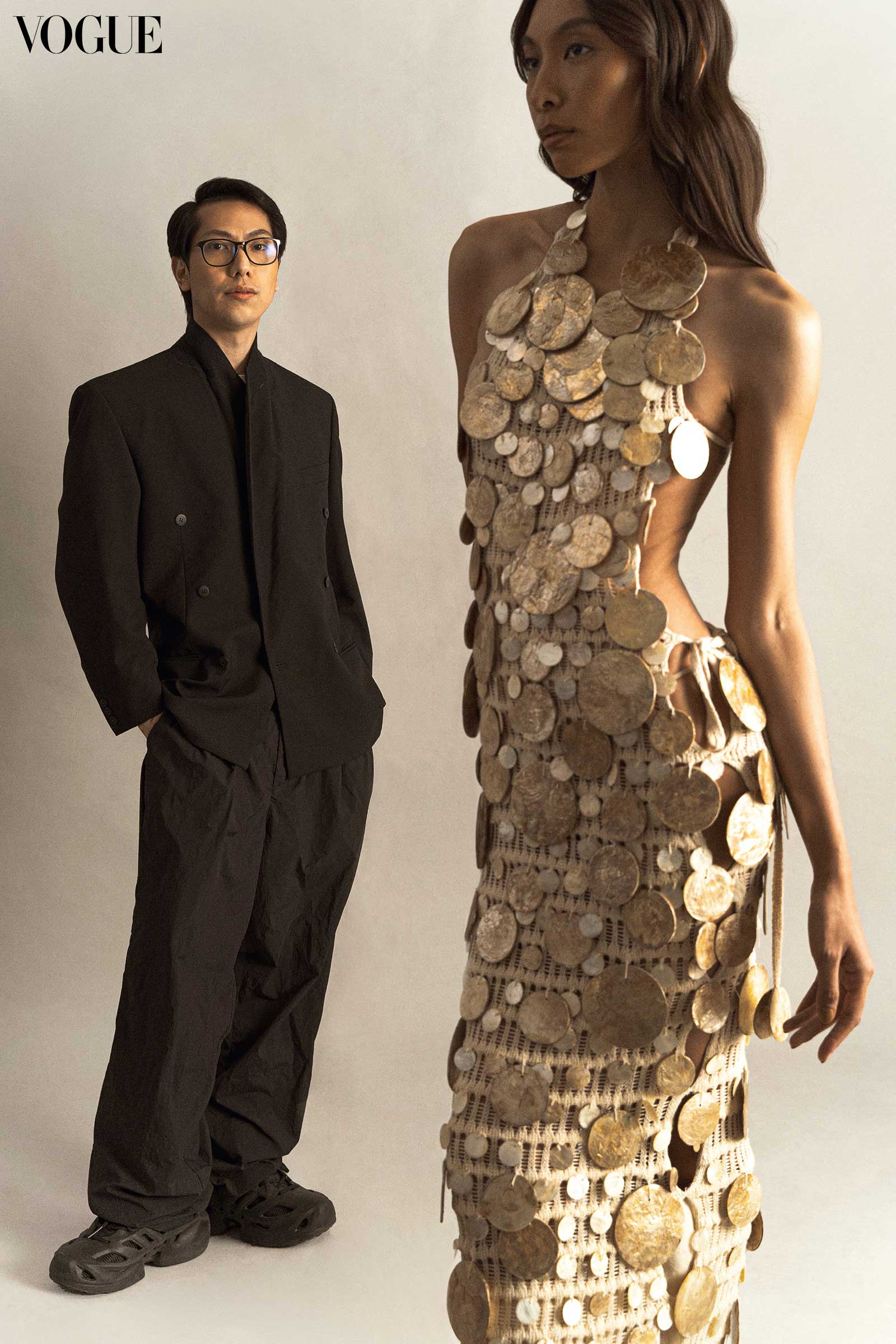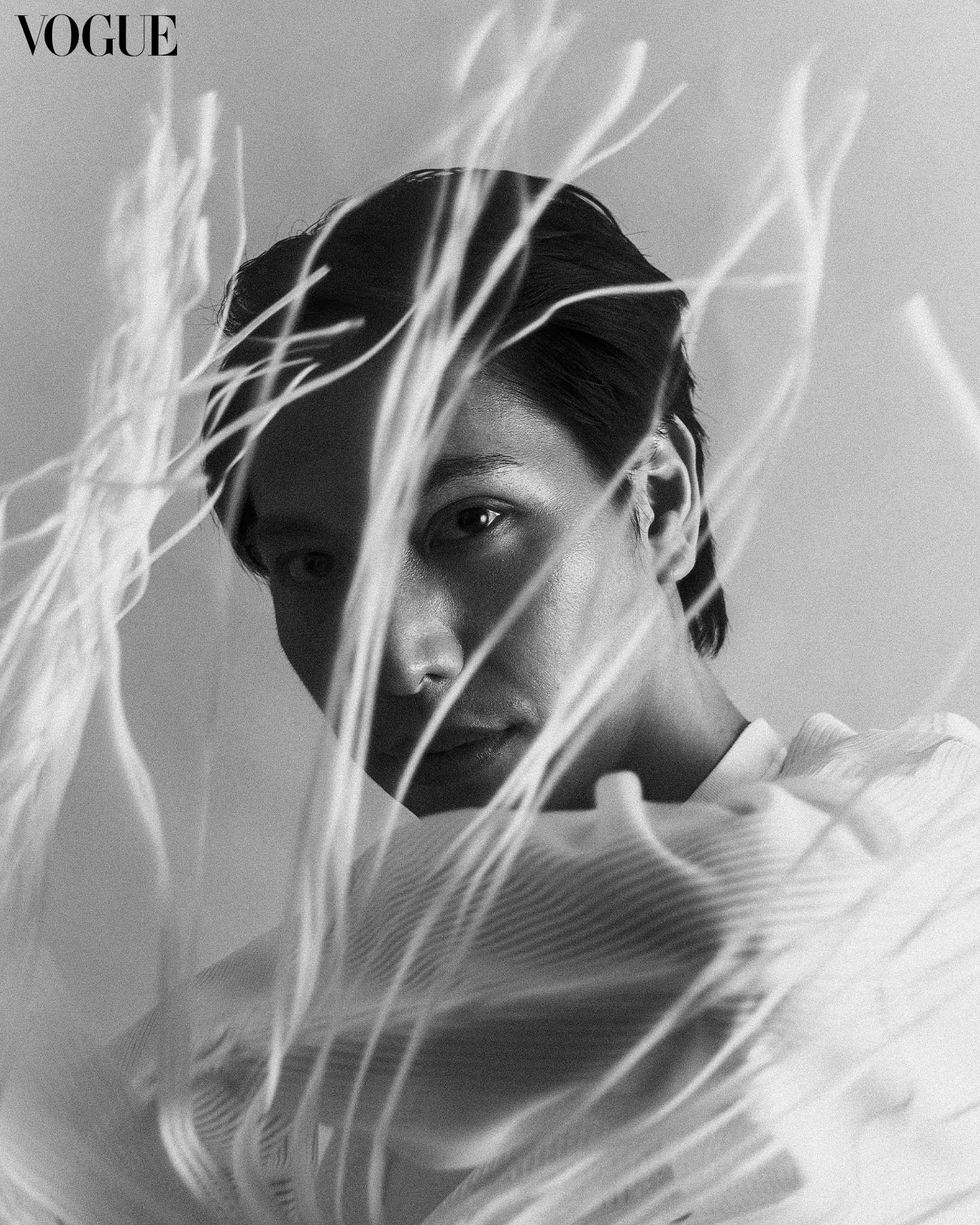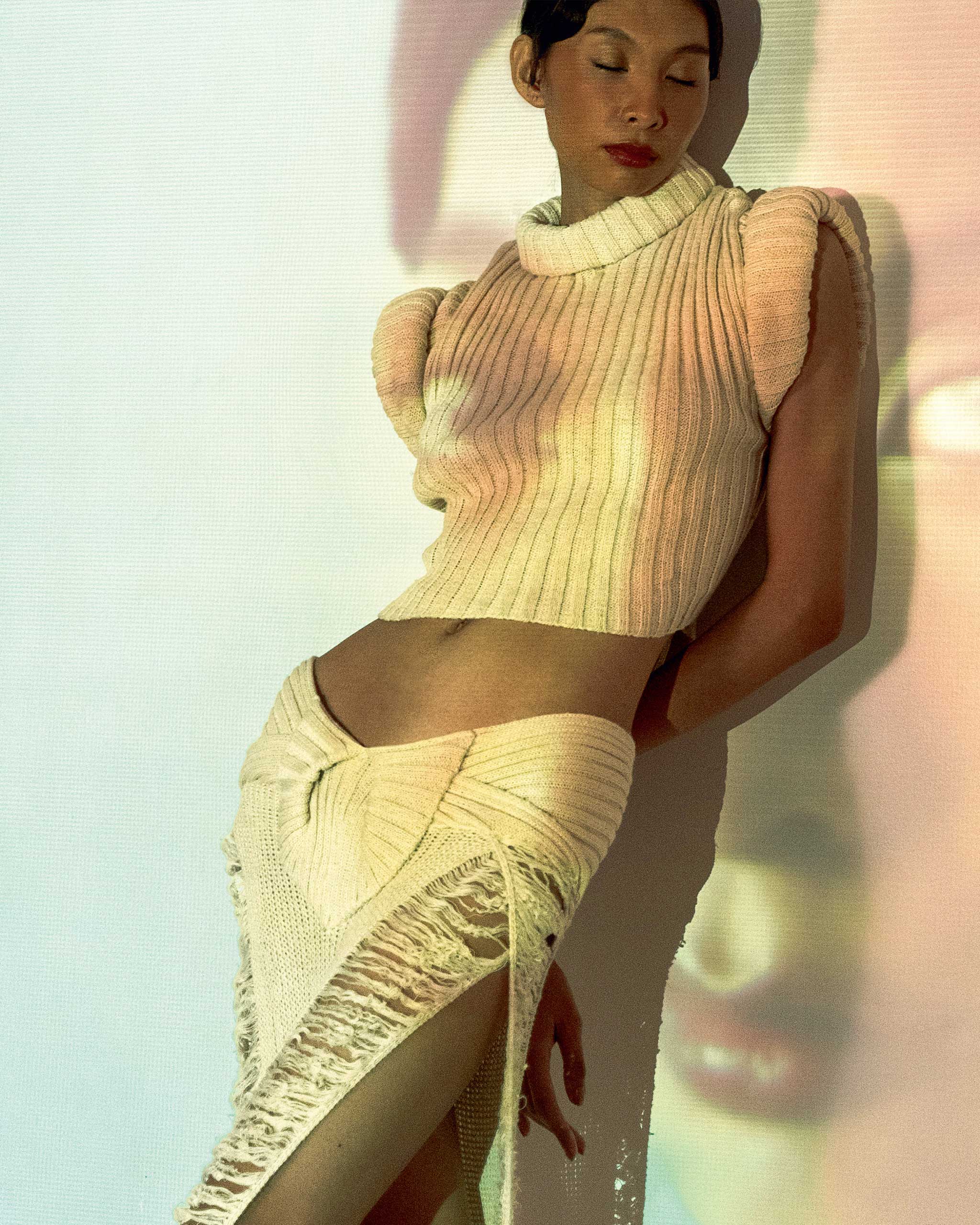Designer Jerome Lorico is drawn to knitwear in his work. “With knits, you can easily manipulate it without altering the material so much,” he tells Vogue. “Like water, it feels alive to me.” Photographed by JL Javier for the March 2024 Issue of Vogue Philippines
In his own words, designer and artist Jerome Lorico walks down the winding road that brought him to where he is now.
Jerome Lorico’s shoot took place a day shy of his birthday. Yet, it was him who came bearing gifts: several large black boxes of bespoke knit and mother of pearl creations, and a seemingly bottomless bag of matcha KitKat bars and butter Pocky sticks brought back from a recent trip to Japan. “It’s for everyone,” he beams, passing snacks around to the team members in between our photographer’s shutter clicks.
His generosity is woven into the fabric of his identity as a designer, too. For our anniversary issue, he and his team dedicated over 400 hours to a dress that would later end up on the cover. Eventually, it becomes apparent that Jerome has much to give because he has received just as much. His attentiveness to the product development and research stage of design, for example, can be traced back to a college degree in English literature; his career in fashion can be traced back to a stint designing samples for his family’s handicraft business.
In an exclusive interview with Vogue Philippines, the designer and artist recalls childhood memories made in trucking containers, revisits an internship of a lifetime, and reminisces the long journey to where he is now, and where he’s headed.
Tell us about your earliest fashion-related memory. How old were you when you realized you wanted to be a designer?
I grew up in a family of craftsmen. My father used to weave baskets and our family was in the handicraft business. I remember I was watching a fashion program on TV and it was the PFDC (Philippine Fashion Design Competition). Jojie Lloren won then in the Philippines, and went on to win the Grand Prix in Paris with his bustier made of abaca fiber. I was amazed to see that a material that we were using in our handicrafts can be made into a fashionable piece. From then on, I was hooked, and started reading more about Philippine fashion and the industry. I was 11.
You’re from Legaspi, Bicol. I read that the first time you traveled to Manila, you had PHP750 and a cigarette box.
I don’t want to romanticize my plight so much, but this is true. I remember having my school bag with me, one duffle bag, and a cigarette box. When you are young and full of dreams, you feel completely invincible. I wanted to have a steady job and be stable first and then follow my dreams of becoming a designer. But I guess the universe had other plans for me.
I saw an ad in the newspaper look- ing for young designers to join the annual PFDC. Fortunately, I got in as one of the semi-finalists. But I had to go back to Bicol to make the garment. We had a month to complete it, but I didn’t have any idea how to make a dress that time. But I knew how to weave and I’m good with textures, so I focused on my strengths. In the end, we had to sell some chickens to finish the garment. It makes me laugh now at the memory, but I realized how much struggle a creative in this country has to go through just to create something. I didn’t have enough technical skills then, but I believe I have the heart. I joined other competitions after that, and fortunately I’ve been successful and really blessed so far. It was probably luck, or I just didn’t want to disappoint those poor chickens.

How do your Bicolano roots inspire you and your work today?
I grew up surrounded by materials. Different indigenous fibers, wood, leaves, roots, bark, and even seeds. I know how to treat them and respect their properties. This gives my work a certain sense of primitivism and unique tactility. But the city is something that also inspires me a lot. So my body of work is always an attempt to merge these two elements. To create something that speaks about where I came from, where I am at the moment, and the space where I envision to be in the future.
Where and how did you learn how to design?
I have memories of playing inside huge trucking containers while they were being filled with baskets, giant paper maché, and home accessories. I also used to fall asleep on top of boxes and huge heaps of abaca fiber as a child. One of the most memorable scents of my childhood is the smell of sulfur. Back then, we used it to make sure that there wouldn’t be any pests or insects on the natural materials before they are shipped abroad. These experiences made me into the creative person that I am now.
That, coupled with mentorship from local designers like Alex Pigao, Frederick Peralta, Tippi Ocampo, PJ Arañador, and Arnel Papa. I also found inspiration from other designers who ended up as good friends like Eric Delos Santos, Bo Parcon, Eugene Tidalgo, Veejay Floresca, Martin Bautista, and Patrick Galang.
You were an intern at Alexander McQueen from October 2012 to March 2013. It must’ve been an interesting time as it was two years after McQueen had passed.
It was really a baptism of fire for me. I was in London for an exhibition at the London Fashion Week and I met someone connected to the company of the fashion house. The interview was unsatisfying in my opinion, but fortunately I had some pieces with me from the exhibit, so I showed it as a last attempt to impress them. I went home crying on the tube and I ended up having a fever for days after that.
Finally an email came, and the rest was a completely surreal experience working in the fashion house. I was under the menswear department. I have been a great follower of McQueen’s work, so seeing some of his collections up close was really a dream come true. I would usually volunteer to go to the archives to pick up some pieces to be used as inspiration for new collections. It was magical being surrounded by pieces of art and beauty especially from someone I really admire and respect.

The collection that impressed the McQueen recruiter was your Estetica SS13 collection that consisted of knitwear. What draws you to the medium?
I believe it is the fluidity of the material that makes me very interested in it. Other materials tend to have limitations, especially woven fabrics. They cannot follow the curvature and the natural shape of
the body unless you cut it on the bias. With knits, you can easily manipulate it without altering the material so much. It’s like giving it the chance to form the shape that it wants to become. Like water, it feels alive to me.
You’ve always been attentive to the usage of responsible materials in your collections. Now, you use local cotton yarns and piña. How do you choose your materials?
Being able to work closely with other artisans from an early age made me appreciate and respect collaboration and the value of good craftsmanship. It also made me very conscious of the materials that I am using, because I know how hard it is to also source, harvest, and process certain materials.
When you are not a farmer, you tend to forget to appreciate the produce that you put on the table. It is true that the only way to respect what we have is to follow the path where it came from.
This year marks your 17th year in the industry. How would you describe your journey?
I never count my years in the industry, so that actually made me feel a bit uncomfortable but in a good way. It made me ask myself if I have done something of value to the industry, and if I was able to contribute something already at this point in my career. I never count accomplishments, but I do count and remember my blessings. And when I feel like my cup is going empty, I always go back to my memories as a young creative in a province that is frequented by typhoons and blackouts, and I am once again inspired.
Photography by JL Javier. Makeup Artist: Nadynne Esguerra. Hairstylist: JA Feliciano. Producer: Bianca Zaragoza. Art Director: Gabbi Constantino. Model: Leila Ibanez of Mercator Models. Photography Assistant: David Ong.
- Origins: Retracing Our History In The Highlands
- A Creative Middle Age: RAFGLANG and Mich Dulce Mark Their Runway Return at Bench Fashion Week
- Jo Ann Bitagcol Returns to the Runway, This Time As A Designer
- On Drag Race, Marina Summers Was A “Filipina Warrior”: Behind The Look with Designer Jude Macasinag
